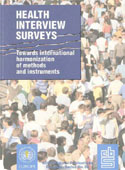Health interview surveys. Towards international harmonization

Download
Edited by A. de Bruin, H.S.V. Picavet & A. Nossikov
WHO Regional Publications, European Series, No. 58
1996, 161 pages
ISBN 92 890 1322 2
This publication is only available online.
Monitoring health is an essential task of country systems for health information and of measuring the European Region's progress towards achieving health for all. The European policy for health for all includes internationally agreed indicators for countries to use. Health interview surveys provide the best - in some cases the only - means to collect data on some of the indicators that reflect more recent public health concerns, such as health-related behaviour and quality of life. The surveys mirror the information that only properly approached individuals may be able to provide and ensure the coverage of all subgroups of the population. Yet they enjoy a long tradition in only a few countries.
Moreover, information on indicators is sometimes not comparable. The methods and instruments of data collection have often been developed without international coordination, or adapted from those in use in other countries, usually with substantial changes to meet local requirements. In addition, countries lacking a tradition of health interviewing are often uncertain about the best way to conduct surveys. The WHO Regional Office for Europe and Statistics Netherlands organized a series of meetings to tackle these problems. The result was the internationally agreed methods and instruments for health interview surveys that are set out in this book. These are likely to become standards, and thus improve the comparability of information.
The book provides practical guidance on health interview surveys. It describes their role in health for all monitoring, the development and use of methods and instruments, and the prospects for harmonizing the surveys across the European Region. It is thus essential reading for all concerned with planning and making such surveys, whether in national statistics offices or in public or private interviewing agencies. It will also be useful to the public health community, including students and academics.



